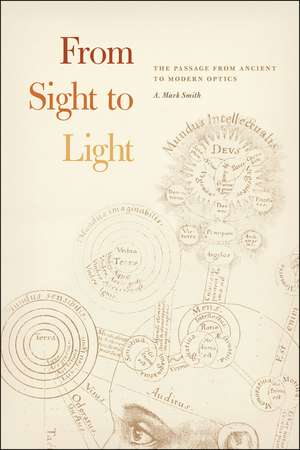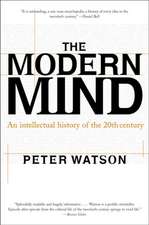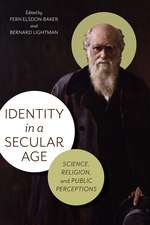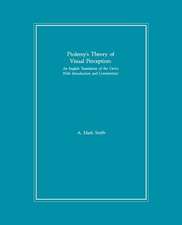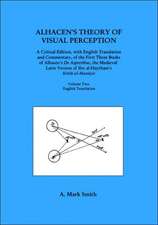From Sight to Light: The Passage from Ancient to Modern Optics
Autor A. Mark Smithen Limba Engleză Paperback – 21 dec 2017
From its inception in Greek antiquity, the science of optics was aimed primarily at explaining sight and accounting for why things look as they do. By the end of the seventeenth century, however, the analytic focus of optics had shifted to light: its fundamental properties and such physical behaviors as reflection, refraction, and diffraction. This dramatic shift—which A. Mark Smith characterizes as the “Keplerian turn”—lies at the heart of this fascinating and pioneering study.
Breaking from previous scholarship that sees Johannes Kepler as the culmination of a long-evolving optical tradition that traced back to Greek antiquity via the Muslim Middle Ages, Smith presents Kepler instead as marking a rupture with this tradition, arguing that his theory of retinal imaging, which was published in 1604, was instrumental in prompting the turn from sight to light. Kepler’s new theory of sight, Smith reveals, thus takes on true historical significance: by treating the eye as a mere light-focusing device rather than an image-producing instrument—as traditionally understood—Kepler’s account of retinal imaging helped spur the shift in analytic focus that eventually led to modern optics.
A sweeping survey, From Sight to Light is poised to become the standard reference for historians of optics as well as those interested more broadly in the history of science, the history of art, and cultural and intellectual history.
Breaking from previous scholarship that sees Johannes Kepler as the culmination of a long-evolving optical tradition that traced back to Greek antiquity via the Muslim Middle Ages, Smith presents Kepler instead as marking a rupture with this tradition, arguing that his theory of retinal imaging, which was published in 1604, was instrumental in prompting the turn from sight to light. Kepler’s new theory of sight, Smith reveals, thus takes on true historical significance: by treating the eye as a mere light-focusing device rather than an image-producing instrument—as traditionally understood—Kepler’s account of retinal imaging helped spur the shift in analytic focus that eventually led to modern optics.
A sweeping survey, From Sight to Light is poised to become the standard reference for historians of optics as well as those interested more broadly in the history of science, the history of art, and cultural and intellectual history.
Preț: 299.72 lei
Nou
Puncte Express: 450
Preț estimativ în valută:
57.36€ • 59.43$ • 47.87£
57.36€ • 59.43$ • 47.87£
Carte tipărită la comandă
Livrare economică 21 martie-04 aprilie
Preluare comenzi: 021 569.72.76
Specificații
ISBN-13: 9780226528571
ISBN-10: 022652857X
Pagini: 480
Ilustrații: 41 halftones, 58 line drawings
Dimensiuni: 152 x 229 x 28 mm
Greutate: 0.62 kg
Editura: University of Chicago Press
Colecția University of Chicago Press
ISBN-10: 022652857X
Pagini: 480
Ilustrații: 41 halftones, 58 line drawings
Dimensiuni: 152 x 229 x 28 mm
Greutate: 0.62 kg
Editura: University of Chicago Press
Colecția University of Chicago Press
Notă biografică
A. Mark Smith is a Curators’ Professor of History at the University of Missouri–Columbia. Among his numerous publications is an eight-volume critical Latin edition and English translation of Alhacen’s De aspectibus.
Cuprins
Preface
Chapter 1 Introduction
Chapter 2 The Emergence of Optics as a Science: The Greek and Early Greco-Roman Background
1 Early Intimations
2 Physical and Psychological Theories of Vision
3 The Anatomical and Physiological Grounds of Vision
4 Theories of Color and Color Perception
5 The Euclidean Visual Ray Theory
6 Euclidean Catoptrics
7 Burning Mirrors and the Analysis of Focal Properties
8 Conclusion
Chapter 3 Ptolemy and the Flowering of Greek Optics
1 The Ptolemaic Account of Visual Perception
2 The Ptolemaic Account of Reflection
3 The Ptolemaic Account of Refraction
4 Atmospheric Refraction and the Moon Illusion
5 Conclusion
Chapter 4 Greco-Roman and Early Arabic Developments
1 Plotinus’s Theory of Visual Perception
2 The Later De anima Commentators
3 Saint Augustine’s Psychological Model: The Inward Ascent
4 The Arabic Transition: The De anima Tradition
5 The Arabic Transition: Geometrical Optics
6 Conclusion
Chapter 5 Alhacen and the Grand Synthesis
1 The Elements of Alhacen’s Analysis
2 Visual Discrimination, Perception, and Conception
3 Reflection and Its Visual Manifestations
4 Refraction and Its Visual Manifestations
5 Conclusion
Chapter 6 Developments in the Medieval Latin West
1 Background to the Translation Movement
2 The Translation Movement and the Inroads of Aristotelianism
3 The Scholastic Analysis of Perception and Cognition
4 Geometrical Optics and the Evolving Science of Perspectiva
5 Conclusion
Chapter 7 The Assimilation of Perspectivist Optics during the Later Middle Ages and Renaissance
1 Optics as a Quadrivial Pursuit in the Arts Curriculum
2 Theology and the Emergence of Optical Literacy
3 Optical Motifs in Literature
4 Renaissance Art, Naturalism, and Optics
5 Conclusion
Chapter 8 The Keplerian Turn and Its Technical Background
1 Technological, Social, and Cultural Changes: 1450–1600
2 Rethinking Concave Mirrors and Convex Lenses
3 Rethinking the Eye
4 Kepler’s Analysis of Retinal Imaging
5 The Analytic Turn
6 The Epistemological Turn
7 Conclusion
Chapter 9 The Seventeenth-Century Response
1 The Conceptual and Cultural Context for the Keplerian Turn
2 Extending Vision in Both Directions
3 New Theories of Light
4 Recasting Color
5 The Epistemological Consequences
6 Conclusion
Bibliography
Index
Chapter 1 Introduction
Chapter 2 The Emergence of Optics as a Science: The Greek and Early Greco-Roman Background
1 Early Intimations
2 Physical and Psychological Theories of Vision
3 The Anatomical and Physiological Grounds of Vision
4 Theories of Color and Color Perception
5 The Euclidean Visual Ray Theory
6 Euclidean Catoptrics
7 Burning Mirrors and the Analysis of Focal Properties
8 Conclusion
Chapter 3 Ptolemy and the Flowering of Greek Optics
1 The Ptolemaic Account of Visual Perception
2 The Ptolemaic Account of Reflection
3 The Ptolemaic Account of Refraction
4 Atmospheric Refraction and the Moon Illusion
5 Conclusion
Chapter 4 Greco-Roman and Early Arabic Developments
1 Plotinus’s Theory of Visual Perception
2 The Later De anima Commentators
3 Saint Augustine’s Psychological Model: The Inward Ascent
4 The Arabic Transition: The De anima Tradition
5 The Arabic Transition: Geometrical Optics
6 Conclusion
Chapter 5 Alhacen and the Grand Synthesis
1 The Elements of Alhacen’s Analysis
2 Visual Discrimination, Perception, and Conception
3 Reflection and Its Visual Manifestations
4 Refraction and Its Visual Manifestations
5 Conclusion
Chapter 6 Developments in the Medieval Latin West
1 Background to the Translation Movement
2 The Translation Movement and the Inroads of Aristotelianism
3 The Scholastic Analysis of Perception and Cognition
4 Geometrical Optics and the Evolving Science of Perspectiva
5 Conclusion
Chapter 7 The Assimilation of Perspectivist Optics during the Later Middle Ages and Renaissance
1 Optics as a Quadrivial Pursuit in the Arts Curriculum
2 Theology and the Emergence of Optical Literacy
3 Optical Motifs in Literature
4 Renaissance Art, Naturalism, and Optics
5 Conclusion
Chapter 8 The Keplerian Turn and Its Technical Background
1 Technological, Social, and Cultural Changes: 1450–1600
2 Rethinking Concave Mirrors and Convex Lenses
3 Rethinking the Eye
4 Kepler’s Analysis of Retinal Imaging
5 The Analytic Turn
6 The Epistemological Turn
7 Conclusion
Chapter 9 The Seventeenth-Century Response
1 The Conceptual and Cultural Context for the Keplerian Turn
2 Extending Vision in Both Directions
3 New Theories of Light
4 Recasting Color
5 The Epistemological Consequences
6 Conclusion
Bibliography
Index
Recenzii
"Absolutely delightful to read, with an elegance far exceeding that of the overwhelming majority of scientific papers. The book holds one's attention and is difficult to put down."
"In what will surely become a canonical work, Smith surveys the development of optics in the Western world from classical Greece through Johannes Kepler. . . . Smith systematically guides readers through all major texts in the history of optics, at times in painstaking detail, making this book a valuable reference work. At the same time, he never lets the big picture recede into the background for too long, consistently and clearly articulating the larger textual traditions and conceptual innovations in his sources and weaving them into a coherent, engaging story and historical argument. Students and faculty alike—in fact, anyone interested in the nature and development of premodern optics—will need to consult this book. Essential."
"A magisterial history of optics over the course of two millennia. . . . This is a must-read for anyone interested in the history of sight, vision, light, and the study thereof."
“The self-proclaimed aim of Mark Smith’s From Sight to Light is to suggest a new historical narrative to replace the late David C. Lindberg’s paradigmatic account of the history of pre-modern optics in Theories of Vision from Al-Kindi to Kepler. Just as Kepler wrote a paralipomena (a supplement) to the epitome of the theory of perspectiva by the medieval mathematician Witelo, Smith suggests this book as a paralipomena to Lindberg’s account. The immediate additions to Lindberg’s grand narrative include a more extensive description of premedieval theories of optics and a detailed analysis of their technical and geometrical aspects, especially those concerned with questions of reflection and refraction. Smith accomplishes this with great clarity, confidently guiding the reader through the intricacies of Euclid, Ptolemy, Alhacen, and Kepler.”
"Over the course of his career, A. Mark Smith has written on the entire history of geometrical optics, from antiquity to the seventeenth century. There is now hardly a single area in this field that has not been transformed by Smith’s careful and lucid explanations of these mathematical theories . . . . As he has done in all his previous work, Smith leads the reader confidently through the history of the science, and through the details of many mathematical proofs. . . . In providing the first comprehensive and mathematically sophisticated account of premodern optics, From Sight to Light will engage and enlighten scholars of the history of ancient, medieval, and early modern optics."
“From Sight to Light is an exciting and valuable addition to the diachronic history of science in an area of crucial importance not only to our understanding of medieval science but also to the formation of modern science itself. This is history of science at its best.”
“In its text-based approach, From Sight to Light offers a convincing conceptual history of optics. Well argued and based on a lifetime of close study of the primary sources, it deserves to be widely read. From Sight to Light has the potential to be a classic alongside David Lindberg's Theories of Vision.”
“No one doubts Kepler’s contribution to optics and vision. But here, as never before, his ancient and medieval debts are set in deeper historical context, and importantly, his dramatic departures are carefully reassessed and critically revised. Smith’s fresh interpretation of the Western optical tradition—impressive in scope and rigor, and written with remarkable clarity—will likely become a classic.”
"Smith’s book is exemplary when it comes to introducing the two millennia of optical research leading up to Kepler, who extended the study of images from the single surface of a mirror to refraction in lenses. And he is right to point out how Kepler’s achievements in geometrical optics link up with some contemporary epistemic concerns."
